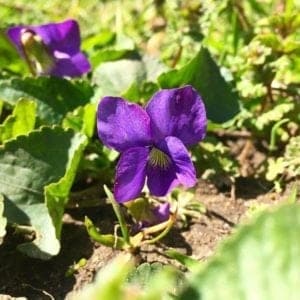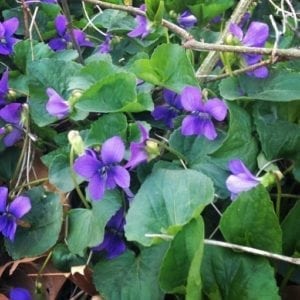Violet: Herb of the Week
Violet (Viola odorata) is one of the first plants up in the spring, and we’re always so happy to see it each year!
Flower Art

Violet is one of many plants that make art: the beautiful purple flower is not actually its reproductive flower. There’s a second flower that happens later in the season, which is green and lower to the ground, which is the reproductive flower. This purple one is basically just for joy!
That’s one of the ways we can work with violet, actually: when your heart is heavy, and feeling wrung out, violet can help bring the soothing relief that can help you see the sun again.
Fluid & Flow

Violet is a moistening lymphatic, which makes it helpful for a variety of dry conditions – whether it’s a dry respiratory infection, or the after-effects of mastectomy, or in this case, a sunny, arid parking lot.
Most plants that stimulate lymphatic movement have a drying effect on the body – which isn’t a bad thing. Think about edema, for example: you’d want to move that excess fluid and dry it out. But in the case of a dry lung infection, or in a person who typically runs dry who has had a mastectomy, we want to keep the lymph moving without drying out the area, and violet is just the plant for the job!
Nutritive Infusion

Did you know, violet is a high-nutrient herb – sort of like a moistening version of nettles. So many people love nettles, but they’re really quite drying. So if you’re a person who runs dry, add equal parts violet and nettles to your nourishing infusion – or just skip the nettles altogether!
When you’re making tea for the nutrient content (and especially for minerals), it’s important to let it steep for a good while – we usually steep it overnight. Put an inch or so of dried violet, nettle, dandelion leaf, red clover, etc into a mason jar and fill it up with boiling water. The next morning, it’ll be dark and rich with vitamin and mineral goodness. I like to add some tulsi and ginger to give it an uplifting mood-boosting zing. There’s a super-simple superfood. Tea is good for you!
Wild Salad

Did you know you can just eat violet leaves? If you’re craving salad lately, you’re not alone: at the end of winter, when everyone’s been eating heartier winter foods, it’s not just your taste buds that want a salad, it’s your liver and kidneys too!
Now that we can get salad all year around at the grocery store, we’ve forgotten how gloriously important these early spring edibles are – next time you’re out for a walk, gather up some violet leaves, dandelion leaves, garlic mustard, and chickweed, and make yourself a salad with real flavor! Eat your weeds – that’s herbalism, too.

1 Comments
Leave a Comment
You must be logged in to post a comment.

Join our newsletter for more herby goodness!
Get our newsletter delivered right to your inbox. You'll be first to hear about free mini-courses, podcast episodes, and other goodies about holistic herbalism.

[…] discussed include violet, betony, kava, pedicularis, green tea, calamus, pine, elecampane, sage, tulsi, goldenrod, […]